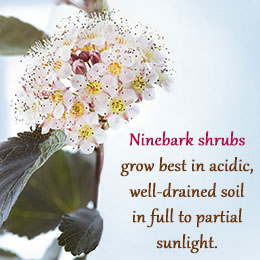Ninebark is a beautiful deciduous shrub, that is a great addition to most gardens. This plant is highly resilient to rough environmental conditions, which allow it to thrive in most places. In this Buzzle article, we will discuss the plant's growth requirements and other care tips that will help it flourish in your garden.
 Did You Know?
Did You Know?
Many indigenous tribes of Canada and America use parts of the Pacific ninebark shrub in their traditional medicine as an emetic, purgative, laxative and also to cure scrofulous sores on the neck, and gonorrhea. However, one should be careful while trying out these cures as some parts of the plant are poisonous.Ninebark (
Physocarpus opulifolius) is a small to medium-sized shrub that is native to North America. It is a favorite in many landscape gardens due to its fascinating and colorful foliage, and beautiful, cup-shaped, white flowers. Many ninebark varieties such as Diablo, Summer Wine, Snowfall, Copertina, Little Devil, Center Glow, Tiny Wine, Am and Gold's Dart are available in nurseries. Each of them grow with different colored foliage, i.e., various shades of purple, green, yellow, and red, and a combination of these plants can create a stunning effect.
The shrub gets its name from its behavior of peeling its bark off in many layers. This plant is also an important part of wildlife ecosystems, where it acts as nesting sites for many birds, and provides sustenance to many insects. When grown in gardens, the ninebark is a very low-maintenance plant, making it easy for even inexperienced gardeners to grow them as hedges, garden screens, and shrub borders. Let us see what are the basic requirements that one must fulfill for this plant to thrive.
Growth Requirements
Soil:The ninebark shrub does not really mind any kind of soil, even those with widely varying pH. However, to get best results, one should plant these shrubs in acidic, well-drained soil that falls in the USDA zone 2-7. They grow well in areas with open bright sunlight, although partial shade will also do. It is important to note that these shrubs can grow approx. 5 feet tall and 12 feet wide. So, you should provide enough space for these plants, especially when placing them in a landscape setting.
Watering: These plants become drought resistant within a year or two after planting. Mild watering 2-3 times in the first 2 years, followed by one watering session every week should be sufficient. Make sure that you water only at the base of the plant as wet leaves attract fungal infections.
Fertilizers: Applying a balanced shrub fertilizer, once a year during spring time, should be enough for the plant's nutritional needs. In addition you can also apply a top dressing of compost annually to enhance the foliage.
Planting Instructions:
- With a shovel or till, loosen the soil to a depth of around 15-20 inches.
- Now, mix a thick layer of compost into the soil.
- Dig a hole that is twice as wide as the pot or container of the shrub.
- Carefully take the shrub out of the pot, and place it in the hole in such a way that the top of the root ball is at the same level as the soil's surface.
- Fill the hole up and gently give it a firm setting.
- Water the plant well.
Pruning Ninebark ShrubsPruning and trimming is probably the most important part of maintaining a ninebark shrub. Performing the following pruning tips regularly will ensure abundant and healthy growth of the plant's foliage, and prevent mildew infection.
- It is best to prune and trim your ninebark shrub during its dormant period, after the end of fall and before the start of spring.
- Use pruning shears to cut long twigs that may be sticking out of the sides and top of the bush. It is best to cut around ¼-inch above the exterior buds that are facing outwards.
- For the inner branches it is best to use lopping shears, to cut at the origin of these branches. However, do not cut more than one-third of the inner branches in the same session.
- Once the plant has stopped blooming, you can perform some light pruning to remove any stray branches.
- If your ninebark shrub has been unattended for a long period of time, it is possible that its growth has turned unruly, with a lot of dead branches. In such cases, cut one-third of the branches to the ground every alternate year till the new growths satisfy you. However, it is important that your plant has been well-established for 2-3 years at least before you undertake such drastic pruning. It is also a good chance to propagate the seeds or cuttings, especially if it is done during spring time.
- It is also good to remove any dying foliage and deadwood regularly, to reduce the chances of disease.
Ninebark Shrub Diseases and PestsNinebark shrubs are resilient to most pests and diseases. However, with extreme weather or neglect, the plant may be attacked by leaf spots, fireblight, powdery mildew, and witch's broom fungal infections. Each of these conditions can be treated with appropriate fungicides. You can try spraying neem oil on the affected areas. It is also recommended to get rid of any dead foliage on the plant and on the ground, and to avoid applying nitrogen fertilizers. Gardeners should also reduce the frequency of watering the plants. This will not affect the plant too much as it is a drought tolerant species. In severe cases, you may have to prune the plant to the ground. However, if none of these steps work, it is best to uproot the plant and try a different variety of ninebark shrub.
The above tips can helping the ninebark to flourish, providing your garden with great beauty for many years, without the need to work too hard.






 Did You Know?
Did You Know?